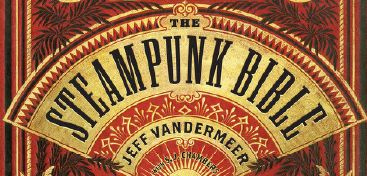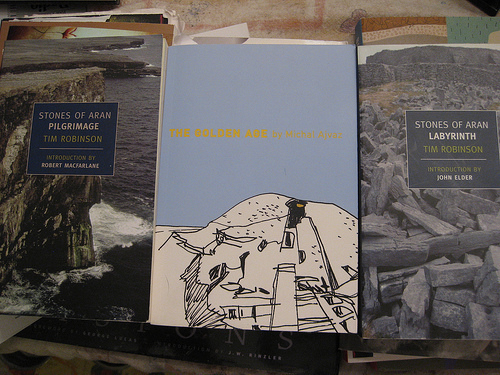Jeff VanderMeer's Blog, page 78
November 5, 2010
Working on The Thackery T. Lambshead Cabinet of Curiosities

(Sneak peek detail from Ivica Stevanovic's amazing full-page art, to accompany the story "Relic" by Jeffrey Ford. A recent series here, too.)
Having finished up most of the editing on the stories and incidental text going into The Thackery T. Lambshead Cabinet of Curiosities, we started compiling the master document today. This also includes placement tags for images and creating a separate image key. The anthology is heavily visual and it wouldn't make any sense to include even thumbnails in the text document. The image key also will contain all of the captions for images—very important because those captions will help contextualize not just the image but also, potentially, the story it accompanies.
Today and through the weekend, we'll be working on the final detail work prior to turning in the anthology to Diana Gill at Eos. It's always important to try to make the master document as consistent as possible format and style-wise, and to do last spell/grammar checks, read-throughs, etc. Our goal during this phase is to make the manuscript as clean for the typesetter and copy-editor as possible, and to give as clear instructions as possible not just about the images but about special cases in the text, like Arabic letters, which we always fear may drop out of the manuscript on the other end. Our friend Gio Clairval, who is in the antho but also an excellent translator, will be checking the German and French in a couple of manuscripts, too.
You can get to this point and get sloppy, and then your life and the publisher's life are both more irritating and difficult when you get the typeset version back.
There's also the challenge of finding high-res images for some stories. For example, Minister Faust needs us to find a Bosnian Course-Hair Hound photo to accompany images of Aleister Crowley and a stapler!! (Not that I'm complaining—we love a good challenge.)
One problem in compiling the manuscript is I keep either chuckling or having my breath taken away reading the material. Jeff Ford's "Relic" just tickles both me and Ann to death, with its recursive lying (sorry, "fabrication") and crazy sermons…and it's just such a wise story, too, about relationships. And then I started replacing Mike Moorcock's single quotes with doubles and kept cackling at this bit early in the story: "The small daughter of a Bermondsey tailor claimed that her half-grown cat Mimi had eaten a fairy. Of course no one would believe her even though she insisted she had seen Mimi nosing around a tiny leg. Rebecca, of course, was rightly punished for telling stories. But a few days later she came to her mother holding triumphantly a little human ear." (Of course, just the title of Cherie Priest's story, "Addison's Clockroach," cracks us up.)
Like I said, though, it's not just laughs. There are serious pieces. Lev Grossman's "…Roboticus the All-Knowing," based on one of the original Mike Mignola illos, starts out absurd but ends up containing a fair amount of pathos. "The Gallows Horse" by Reza Negarestani is…well, it's just genius and audacious. Alan Moore's "Objects Discovered in a Novel Under Construction" could've just been a joke about his half-finished novel, but instead it's very much a highlight of the book. Caitlin R. Kiernan's key to a key is extremely creepy. Amal El-Mohtar's "The Singing Fish" is a perfectly executed story about art and influence. Ted Chiang, N.K. Jemisin, Rachel Swirsky…I could go on and on.
One thing that I think makes this anthology superior to its predecessor The Thackery T. Lambshead Pocket Guide to Eccentric & Discredited Diseases is that we've provided contributors with several different ways to tell stories, ranging from the traditional to the more Borgesian—and the emotional range seems wider as a result.
The style of the various pieces of art is also more diverse. There's certainly some neo-Victorian/Steampunk influence, but, ya know, Lambshead was only ten in 1910, so most of the stories and the artifacts cover various periods throughout the twentieth century. At last count, 20 to 25 different artists are contributing, with John Coulthart providing focus/cohesion through section title pages and piece work. The format will be an oversized hardcover with the cover printed right on the boards.
In short, this thing is going to be Mighty. (Full disclosure of TOC will occur in the next couple of weeks, on another website…)
P.S. Can we just say…our editor Diana Gill and Will Hinton at Eos have been wonderful.

(Detail from a J.K. Potter piece in the antho.)
Working on The Thackery T. Lambshead Cabinet of Curiosities originally appeared on Ecstatic Days on November 5, 2010.




November 4, 2010
Amazon's Best Books of 2010: Top 10 Science Fiction/Fantasy

Amazon has just revealed their top 10 SF/Fantasy books of the year, as well as a general top 100, and I've posted two blog entries showcasing all ten titles. The writers on the list are Michal Ajvaz, Charles Yu, Karen Lord, Felix Gilman, N.K. Jemisin, Grace Krilanovich, Dexter Palmer, Nnedi Okorafor, Brian Conn, and Richard Kadrey. The order kept changing and if I had my druthers the list wouldn't be numbered at all, but in the end Michal Ajvaz won out. The list reflects consultation with Amazon editors and my own reading throughout the year.
Ajvaz's The Golden Age was a brilliant act of imagination that showcased this Czech writer's amazing talent—a career-defining book. Charles Yu single-handedly revived the time travel story with a short novel both inventive and poignant. Karen Lord's Redemption in Indigo is a miracle of storytelling ability and compression and generosity. The dialogue and characters and quality of writing in Felix Gilman's novel took me by surprise several times, and the book displays complexity and moral ambiguity at every turn. N.K. Jemisin's wonderful Hundred Thousand Kingdoms plots a non-trad course for fantasy in the twenty-first century. Grace Krilanovich created an amazing phantasmagorical Pacific Northwest in her The Orange Eats Creeps. Dexter Palmer revitalized retro-futurism by way of The Tempest and his own absurdist imagination, while Nnedi Okorafor's novel Who Fears Death features a brave and original heroine and a unique, often heart-breaking story. Finally, Brian Conn's The Fixed Stars is a awesomely strange post-capitalist surreal SF mosaic novel and Richard Kadrey continues to mix pop culture and genre tropes in bold, high-energy recombinations.
Anyway, I'll post about a "second ten" of worthy novels next week, as well as posts on anthologies and story collections before the end of the year. I've also invited each writer on the top 10 list to submit their own top 10 list—either of books read during the year, favorite books, or books specifically from 2010–and will post those on Omnivoracious as they come in.
Amazon's Best Books of 2010: Top 10 Science Fiction/Fantasy originally appeared on Ecstatic Days on November 4, 2010.




What We Need
Less hyperbole. More "we" and less "I". Fewer opinions. More facts. More trust. Less suspicion. More affection and appreciation. More reading and less talking. More common ground. More doing and less talking. Less group-speak and more unique voices. Fewer ideologues and more individuals. More community bonds. More appreciation for our physical environment.
What We Need originally appeared on Ecstatic Days on November 4, 2010.




November 3, 2010
Amazon's Top 100 Books of 2010–Tweeting Now
Over on Omnivoracious, books editor Tom Nissley just posted that they're revealing the Amazon top 100 via their twitter feed all today. Tomorrow, the individual lists for YA, etc., go live, including my SF/F Top 10, which should please everyone and no one. At least one title on the top 100 is also on the SF/F top 10, possibly more.
I'll also post a two-part entry on Omnivoracious tomorrow going over the selections in detail, followed by a separate post by Friday on "the second 10″. By end of year, I'll also blog about short story collections and anthologies. This year there were so many interesting novels, the top 10 list doesn't include anything but novels.
Meanwhile, while we're waiting for all of this to be unveiled, feel free to post your picks here. And, you know, read. I think a lot of us spend entirely too much time blogging and not enough reading. Which is usually what gets us in trouble. :) Don't be like me–go read a book.
UPDATE: They've posted the next 10. (just let that serve for the next ten, and the ten after that…)
UPDATED UPDATED: My post on Dalkey Archive books, leaning heavily on the OF Blog and prior posts from Felix Gilman on his the Half-Made World.
Amazon's Top 100 Books of 2010–Tweeting Now originally appeared on Ecstatic Days on November 3, 2010.




November 1, 2010
I Remember…There *Is* a Difference
I Remember…There *Is* a Difference originally appeared on Ecstatic Days on November 1, 2010.
The Steampunk Bible: The Cover Revealed!
Here's the cover!
Oh, snap. It's not here, just a piece of it. It's really debuting on S.J. Chambers' blog, so go ahead and click here and ooh and aahh over there…
The Steampunk Bible: The Cover Revealed! originally appeared on Ecstatic Days on November 1, 2010.
Peace of Mind
Evil Monkey: Do you monitor the blogosphere when you write?
Jeff: No.
Evil Monkey: Do you take things away from the blogosphere to think about when you write?
Jeff: No.
Evil Monkey: Irresponsible! Unjust!
Jeff: I don't want any kind of white noise in my head. I'm going to write what I'm going to write.
Evil Monkey: Don't you need voices in your head to help?!
Jeff: No. Do you?
Evil Monkey: Heck no! Because I'm the voice in your head.
Peace of Mind originally appeared on Ecstatic Days on November 1, 2010.




October 31, 2010
World Fantasy Award Winners Announced
Congrats to all of the winners! I've blogged the full list, with a few thoughts, at Omnivoracious. The Mieville is a worthy winner, although I thought Kiernan's novel should've won. I didn't hold out any hope for Finch although I'll put it up against anything out there.
Nothing really controversial in the winners' list, except in the short story collection category. I've read the Petrushevskaya collection and I thought it stank up the joint. I'm particularly happy to see Strange Horizons win.
P.S. Let's all do a really really good job of passing along the next year's judges list so that we can make this a truly "world" World Fantasy Award. There should be more than enough stuff in translation, etc., to make a dent. All that's needed is for publishers, editors, etc., to make sure the judges get the material.
World Fantasy Award Winners Announced originally appeared on Ecstatic Days on October 31, 2010.
October 30, 2010
State of the Vander Union: Updates on Weird, Steampunk Reloaded, The Lambshead Cabinet, Steampunk Bible, Borne, and More

(Steampunk Reloaded contributor copies lined up and ready to be packaged and shipped off.)
It's that time again–project updates! Woo-hoo!
Steampunk Reloaded (Tachyon Publications). Co-edited with Ann, this antho is in stores, and contributor copies will be on their way next week. In mid-November, we will post Brazilian and Portuguese Steampunk translation teasers from Vaporpunk, along with an original Jacques Barcia story from a prior Brazilian anthology. Publishers Weekly gave the anthology a starred review and we've been blessed with many positive notices, including USA Today's Pop Candy mentioning it as their book of the week.
The Weird (Atlantic/Corvus). This 750,000-word, 100-year retrospective, co-edited with Ann, has been rescheduled for next year. We'll announce the TOC and the new publication date sometime in late November, along with some new anthology projects. (We tried to notify all contributors, but with 114 stories we might've missed someone.)
The Thackery T. Lambshead Cabinet of Curiosities (Eos/HarperCollins). Except for a couple of stragglers, Ann and I now have all art, stories, and incidental text in hand, including a few rather wonderful surprises. Despite a hectic schedule, Alan Moore has turned in "Objects Discovered in a Novel Under Construction" and Naomi Novik just sent us "Lord Dunsany's Teacup." This in addition to Jeffrey Ford's rather insanely great long story "Relic" and a ton of other amazing stuff. The number of images has gone steadily upward until we can say with confidence that this will be the most visual anthology we've ever done. John Coulthart is contributing art, some interior design, and a stunning series of title pages for the various sections. The full TOC will be announced in a couple of weeks. Publication is set for June 2011, and will be in an oversized hardcover 7 x 9 format, with the cover printed right on the boards. Currently available for preorder on Amazon at a greatly reduced price.
The Steampunk Bible: An Illustrated Guide to the World of Imaginary Airships, Corsets and Goggles, Mad Scientists, and Strange Literature (Abrams Image). This coffee table book by me and S.J. Chambers covers all aspects of the Steampunk subculture, from art to fiction, movies to comics and everything inbetween. We've finalized the text and the images. A last run-through to add image credits and it's a matter of proofs from the printer and it'll go to press. The book will be a 7 x 10 hardcover with the cover printed right on the boards. It's currently available for preorder on Amazon for a ridiculously low price, and will be published in April-May of 2011.
Borne (?): Originally sold to Subterranean Press as a novella, the story has clearly become a novel, which I should have finished by late January at the latest. Subterranean has been kind enough to let me submit another story–something that will be novella length–for book publication next year. Borne will be submitted to publishers once its done, rather than pre-sold. In short, this means two books of fiction soonish.
The Troika by Stepan Chapman (Ministry of Whimsy): To mark the 15th anniversary of Ministry publishing Chapman's PK Dick Award-winning novel, we will repackage it in 2011 in a deluxe e-book edition with lots of extras. Thanks to our parent publisher, Wyrm (Neil Clarke), for greenlighting this project. We don't have a set publication date yet.
…as for other projects…let's just say we've got an original, new story from Michal Ajvaz in hand for [REDACTED TOP SECRET] and expect more work soon from Leena Krohn and others for the same book. We should also know soon whether we will add the next volume of Leviathan into the mix toward the end of 2011. Ann, meanwhile, will have some important updates/news about changes re Weird Tales in the next couple of months.
State of the Vander Union: Updates on Weird, Steampunk Reloaded, The Lambshead Cabinet, Steampunk Bible, Borne, and More originally appeared on Ecstatic Days on October 30, 2010.
Interesting Juxtapositions: Michal Ajvaz's The Golden Age and Tim Robinson's Stones of Aran
What do we mean by slow- versus fast-paced in the books we read? What is the nature of "action" versus "introspection"? Where do nonfiction and fiction have commonalities and interstices?
These are just a few of the general questions I have been asking myself as I re-read and savor Michal Ajvaz's The Golden Age, a novel about an imaginary island in the Atlantic and begin to read for the first time Tim Robinson's two-volume Stones of Aran, Pilgrimmage (his trek around the edge) and also Labyrinth (his journey in the interior), about the Aran islands off the coast of Ireland.
Both the Ajvaz and the Robinson are meditations of a sort, both are recursive, both encompass folktale, history, biology, anthropology, geology, architecture, and a myriad of other elements to tell their stories.
Readers who glut themselves on one type of book—thrillers, for example—will need to adjust to the pacing of both authors. However, read in concert, the Ajvaz and the Robinson place the reader in a different context with regard to pacing. The Robinson is so wonderfully and intensely poetic, without being in the least bit florid, that you must read and re-read each chapter for fear of missing something. The Ajvaz has a kind of dreamy intensity, with a specificity that lies somewhere other than the landscapes.
The effect is as if Robinson were the rock you hold onto to in the middle of the Ajvaz River, which glints and glides along hypnotically. You can better appreciate the pacing of the Ajvaz in the context of Robinson, and you soon begin to notice the changes in that pacing much more acutely than if you had paired the novel with, say, Elmore Leonard.
Similarly, the Ajvaz, with its somewhat different focus and different idea of specificity of detail, complements the Robinson by its blurring of fact and fiction, so that in returning to the Robinson you look for fiction in the fact, and you expect story where normally you would see only description.
Which is to say, you have now entered the real-time of the authors' vision, no longer resistant, and now that you're synched to it, you are able to appreciate the amazing, strange, and at times transcendent treasures to be found within each book.
Both Ajvaz and Robinson know how to stop Time. Both know how to make a single moment an epiphany, a single detail. Both know how to immerse the reader, if the reader is willing to give him or herself up to being immersed.
Which leads me to the question, what juxtapositions in your reading have you found most useful, unsettling, or revelatory?
Interesting Juxtapositions: Michal Ajvaz's The Golden Age and Tim Robinson's Stones of Aran originally appeared on Ecstatic Days on October 30, 2010.









